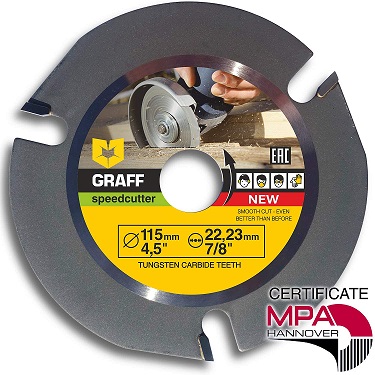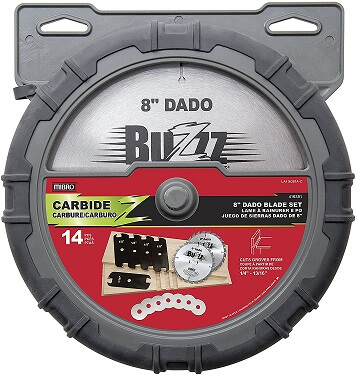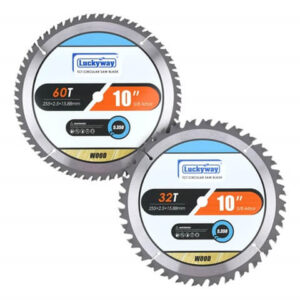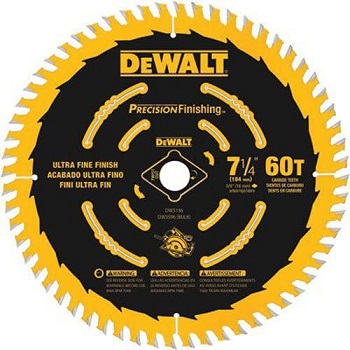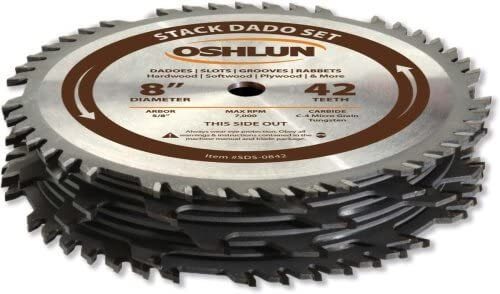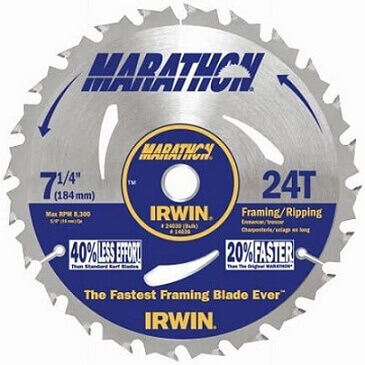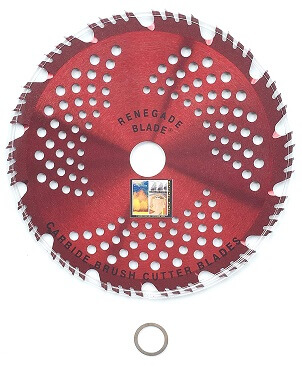“Find the right blade for your circular saw from out carefully picked products.”
Circular saw blades vary in size and the number of teeth. This difference changes how they cut and what materials they work best on. They are perfect for cutting straight lines, angles, and across boards. This makes them a must-have in any workshop. If you are looking to invest in the best circular saw blades, then we recommend considering the below key factors.
- Blade Type: Choose from carbide-tipped, high-speed steel (HSS), or diamond-tipped blades based on your material, be it hardwood, softwood, plywood, or metal.
- Blade Size: Opt for blade diameters from the compact 4.5 inches for detailed work to the larger 12 inches for substantial cuts, tailoring the depth to your project needs.
- Teeth Count: Select the teeth count for your desired finish; higher counts (60+) for smooth cuts in wood, or lower counts (around 24) for quicker, rougher cuts.
In addition to these crucial elements, further details are available in the referenced “Buying Guide”. Additionally, a curated list of the top 7 circular saw blades is provided.
Best Circular Saw Blades Table
| Circular Saw Blade | Blade Type | Blade Size | Teeth Count | Buy Now |
|---|---|---|---|---|
| Graff Circular Saw Blade | Wood | 4 ½ inch | 3 teeth | Check On Amazon |
| Mibro Circular Saw Blade | Metal | 8 inch | - | Check On Amazon |
| Luckyway Circular Saw Blade | Alloy Steel | 5 ½ inch | 60 teeth | Check On Amazon |
| Dewalt Circular Saw Blade | Wood | 7 ¼ inch | 60 teeth | Check On Amazon |
| Oshlun Circular Saw Blade | Wood | 8 inch | 42 teeth | Check On Amazon |
| Irwin Tools Circular Saw Blade | N.A | 7 1/4-inch | 24 teeth | Check On Amazon |
| Renegade Circular Saw Blade | Wood | 8 inch | 56 teeth | Check On Amazon |
7 Best Circular Saw Blades Reviews
1. Graff Circular Saw Blade
GRAFF SPEEDCUTTER 4 ½ Wood Carving Disc is an innovative tool transforming woodworking. Crafted from top-notch tool steel with tungsten carbide teeth, this circular saw blade ensures accurate cuts through laser sharpening. Operating at 13,200 RPM, it maintains coolness during extended use, thanks to low radial resistance. Its unique design reduces kickback, enhancing safety compared to chainsaws. Certified by MPA Hannover, it’s a reliable choice for effortless wood carving, sculpting, and shaping.
Specifications
- Material: Wood
- Brand: GRAFF
- Dimensions: 4.5″L x 4.5″W
- Number of Teeth: 3
- Style: Cutting and Carving
- Arbor Size: 7/8″
- Compatibility: Wood
Pros
- Exceptional cutting sharpness.
- Heat-resistant construction for extended use.
- Certified safety standards.
- Versatile functionality for various woodworking tasks.
Cons
- Limited suitability for certain wood types.
2. Mibro Circular Saw Blade
The Mibro Group 416381 Carbide Stacking Dado Blade Set is a comprehensive kit containing 14 pieces, featuring two 8-inch outer blades, five two-wing chippers, and seven metal shims for precise adjustments. It is crafted to deliver clean cuts with square edges and flat bottoms, ensuring smooth grooves across different wood types. Equipped with carbide tooth blades and chippers boasting negative hook angles, it guarantees a splinter-free finish. Offering slot widths from 1/4 inch to 13/16 inch in 1/16 inch increments, this set caters to various woodworking needs with versatility and accuracy.
Specifications
- Material: Plastic
- Brand: Mibro
- Number of Teeth: 24
- Style: Set
- Item Weight: 0.2 Pounds
- Compatibility: Metal
- Number of Pieces: 14
Pros
- Smooth and precise grooving performance.
- Comprehensive set for versatile applications.
- Negative hook angles for splinter-free finishes.
- Fine adjustment capability with included metal shims.
Cons
- Quality issues with blade performance over time.
3. Luckyway Circular Saw Blade
The Luckyway 2-Pack 10 Inch Miter/Table Saw Blades includes two circular saw blades: one with 32 teeth and the other with 60 teeth. These blades are suitable for cutting a variety of materials such as softwood, hardwood, and plywood. Made from fully hardened steel with tungsten carbide teeth, they offer precise cutting, resistance to bending, and efficient chip removal. The ATB (Alternating Top Bevel) tooth design ensures smooth cuts with minimal splintering. These blades are durable and heat-resistant, ensuring long-lasting and effective performance.
Specifications:
- Material: #65 Mn for matrix; Tungsten carbide teeth
- Brand: Luckyway
- Dimensions: 10″L x 10″W
- Number of Teeth: 32 & 60
- Style: Miter Saw; Table Saw; Circular Saw
- Arbor Size: 5/8″
- Compatibility: Alloy Steel
- Number of Pieces: 2
Pros:
- Sharpness ensures smooth and precise cuts.
- Versatile for various cutting applications.
- ATB tooth design reduces splintering.
- High-quality construction for durability.
Cons:
- Some experienced teeth bending under stress.
4. Dewalt Circular Saw Blade
The DEWALT Circular Saw Blade, sized at 7 1/4 inches with 60 teeth for cutting wood (DWA171460), is known for its durability and long-lasting performance. Its tough coat anti-stick coating reduces friction, ensuring smooth cuts. With a thin kerf design, it delivers precise cuts, while the reinforced shoulder boosts its resilience against impacts, making it ideal for cutting wood with embedded nails. Versatile in its applications, it suits framing, cross-cutting, and fine finishing tasks. Compatible with both corded and cordless circular saws, this blade offers excellent performance and ease of use.
Specifications
- Material: Wood
- Brand: DEWALT
- Product Dimensions: 7.25″L x 7.25″W
- Number of Teeth: 60
- Style: New
- Item Weight: 0.56 Pounds
- Compatible Material: Wood
- Number of Pieces: 60
Pros
- Exceptional durability and wear-resistance.
- Thin kerf design for smooth and precise cuts.
- Tough coat anti-stick coating reduces friction.
- Reinforced shoulder enhances impact resistance.
Cons
- Lack of clear indication of carbide on the blade.
5. Oshlun Circular Saw Blade
The Oshlun SDS-0842 8-Inch 42 Tooth Stack Dado Set with 5/8-Inch Arbor offers woodworkers a top-notch cutting solution at a reasonable price. With 16 pieces in total, including saws and chippers with plenty of teeth, it delivers clean dado cuts from 1/4-Inch to 29/32-Inch. Crafted from durable C-4 carbide, the precision-ground tips ensure longevity. Full body chippers simplify setup and minimize vibration compared to wing-style chippers. Each set includes clear setup instructions, a shim set for precise adjustments, and a handy storage case in full color. It’s a professional-grade choice that won’t break the bank.
Specifications
- Material: Carbide
- Brand: OSHLUN
- Item Dimensions: 10.5 x 9.9 x 3 inches
- Tool Flute Type: Straight
- Surface Recommendation: Engineered Wood
- Dado Saw Teeth: 42
- Arbor: 5/8 Inch
- Chipper Teeth: 6
Pros
- Premium quality at an affordable price.
- Smooth bottom dado cuts with precision.
- Includes detailed setup instructions and shim set.
- Full body chippers for easier setup and reduced vibration.
Cons
- May require additional fine-tuning for optimal performance.
6. Irwin Tools Circular Saw Blade
The IRWIN Tools MARATHON Carbide Corded Circular Saw Blade (model number 24030) is a 7 1/4-inch blade with 24 teeth designed for smooth cutting across various materials. Its silicone coating minimizes pitch and resin buildup, especially with pressure-treated lumber. Constructed with durable carbide teeth, this blade lasts longer and cuts faster. Its unique design alternates thinner and regular teeth for improved cutting efficiency. Heat vent and expansion slots reduce vibration, extending the blade’s lifespan and ensuring straight cuts. Ideal for framing, ripping, and deck work, these 24-tooth blades consistently deliver dependable performance.
Specifications
- Material: Blend
- Brand: IRWIN
- Number of Teeth: 24
- Style: 7 1/4″, 24T
- Item Weight: 1.6 Ounces
- Number of Pieces: 1
Pros
- Excellent quality and durability.
- Smooth cuts for framing and deck jobs.
- Silicone coat reduces pitch and resin buildup.
- Innovative heat vent design reduces vibration.
Cons
- Limited compatibility with certain circular saw models.
7. Renegade Circular Saw Blade
The Renegade Blade 2-pack features two 8-inch, 56-tooth blades suitable for various cutting tasks. With a unique hybrid design and carbide tips, they offer versatility and durability. These blades fit arbors of both 25.4mm (1 inch) and 20mm, ensuring compatibility across different tools. Designed for cutting thick tree limbs, medium bushes, and small branches, they’re fortified with a special carbide blend for enhanced strength. Renegade Blade is the only carbide brush blade brand on Amazon with UL, LLC certification, guaranteeing reliability and safety.
Specifications
- Material: Wood
- Brand: Renegade Blade
- Product Dimensions: 8″L x 8″W
- Number of Teeth: 56
- Style: Industrial
- Item Weight: 1.7 Pounds
- Compatible Material: Wood
- Number of Pieces: 2
Pros
- Versatile for various cutting tasks.
- Universal fit for different arbor sizes.
- Durable carbide-tipped design.
- Reliable performance with UL certification.
Cons
- Limited durability reported under heavy use.
How to Choose the Best Circular Saw Blades
Using a circular saw quite often will make its blade get blunt over time. Replacing a new blade is the right option rather than sharpening it. There are so many aspects to consider while shopping for circular saw blades. This guide will help you to know what to consider and how to pick the right saw blade, as per your requirement.
Let’s get into its details.
1. Blade Types
It is essential to choose the circular saw blades depending on the type of material you are cutting, and the way you cut the material. Usually, manufacturers design blades for cutting specific materials like plywood, laminate, and aluminum, which is mentioned on the saw blade for easy identification.
Here are some of the most commonly used circular saw blades in our daily life. Take a closer look at them and pick the right one as per your cutting requirements.
- Metal – The metal blades are meant to cut through metals, but they are not the same. It let you select the option between an abrasive blade that resembles closely what you use on the rotary cut-off tool (or) traditional design having teeth. Which one to choose is based on certain factors like the tool you’re using. However, the traditional type works well at lower operational rates, while abrasive blades are designed for machines producing high speeds.
- Wood – As the name implies, the wood circular saw blades are designed to cut through wood, and there are a wide variety of options available. Depending on the type of cutting work you are performing will help to decide/select the blade for wood cutting. These blades are used to make cross cuts, rip cuts and a combination of both. If you don’t choose the right blade, then it will result in producing low-quality cuts and even ruin the workpiece.
- Masonry – There are various kinds of masonry saw blades designed to make dry or wet cuts on different materials. However, choosing the right type of blade is essential, which depends on the work you are performing and the environment. Specialized blades will deliver great results for recommended use compared to all-purpose blades, yet need to change blades quite often. Combination blades reduce the downtime due to blade changing but rip or crosscuts are of low quality than if used specialized blades for each cut you make.
Also, there are standard circular saw blades (cut wood or wood composites or plastic), continuous-rim or diamond-edged blades (cut tiles and slate, can work on either dry or wet cutting applications), turbo-rim blades (same as diamond blades, cut concrete and brick), segmented blades (can handle tough materials like concrete or brick but leave rough finish), and abrasive blades (metal cutting, abrasive material like silicon carbide or aluminum oxide) available in the market.
2. Size of the Blade
One has to check whether the blade size they purchase should fit properly to their circular saw or not. Since a small blade won’t fit on a large saw and a large blade doesn’t fit on a small saw. So, it has to fit properly to make it use effectively and effortlessly. However, most blades and saws have readily available dimensions. For instance, a saw using 7 ½-inch blades, then it is the exact blade size you need to buy.
If you are looking to use a blade for metal cutting, then it should be around 14-inches in size. If using a handheld power saw, then the blade diameter will range from 7 – 10 inches. While a general-purpose circular saw blades come within 6 ½ to 8 ¼ inches, which works great for both heavy-duty and light-duty applications.
There are some smaller special circular saws with a blade size of 4 ¼ – 4½ inches, which are mainly used for cutting woods, paneling and other thin materials.
3. Type of Saw
Circular saws will come in various designs, styles, and types. So, you have to purchase the blades that are designed for your saw type. This means the blade and the saw should work together in a harmony. Thus, it provides the best cuts and ensures both the saw and blade will last longer.
The arbor of your purchased blade should match with the shaft of the saw. Here the middle hole of a saw blade where the blade attaches to the saw is referred to as the arbor. While the shaft is referred to as the part of the saw where the blade attaches to. These two has to line up properly or it may cause damage to either your blade or saw.
Also, you have to consider what the saw is meant to cut. In case, if you put a metal cutting blade on a wood cutting saw, then it won’t generate better cuts and may reduce the lifespan of the blade. So, it is a must to match the saw’s purpose to the blade you are using on it.
4. Arbor Size
The arbor size will determine whether the blade is compatible with the saw or not. Most blades come with a standard arbor size of the 5/8-inch diamond- or round-shaped, while some other blades have a 7/8-inch arbor size.
Always use perfectly fitting blades to your arbor or else the blade will wiggle, and thereby results in poor performance or accidents. Most saw blades feature a 5/8-inch circular hole with perforations that let you punch the middle to fit a diamond arbor. For an odd-sized arbor, it is better to invest in a bushing that allows you to adapt the saw’s arbor to fit common sizes.
5. Number of Teeth
The diameter of the blade will determine the actual number of teeth it should possess. Different size blades feature a different number of teeth counts.
Blades with fewer teeth generate larger gullets that quickly removes the material and prevent clogging. Thus, it aids in faster cuts with rough edges and it is quite essential for lengthwise cuts. While blades with higher teeth count deliver sharper, cleaner, and more precise cuts. So, for those planning to perform a lot of work requiring clean and sharp cuts, then pick the blades with more tooth counts.
How do I know the required teeth count on my saw blade? This question arises while buying the saw blades. For this, you have to check the type of material you are working with. For instance, if you are dealing with softwood (or similar materials), then blades with fewer teeth will work well. While harder materials require a blade with more teeth.
Generally, a higher tooth count per inch (TPI) will result in a smoother cut and can easily cut through materials like hardwood and sheet metal. Whereas, lower TPI delivers rougher cut and can cope with softer materials with less precise cutting. Usually, blades with 14 – 18 TPI are widely used for general-purpose projects.
Here is a table that gives a clear idea on how to choose the TPI as per your requirement.
| Type of Blade | TPI | Total Number of Teeth (Average) | Works Best For |
| Coarse | 3 – 8 | 40 – 60 | Softwood, Lumber, MDF, Hardwood |
| Medium | 8 – 18 | 60 – 80 | Hardwood, Lumber, Plyboard, Softwood, Sheet Metals, & MDF |
| Fine | 18 – 32 | 80 – 120 | Plyboard, Sheet Material, Frames, Non-Ferrous Metals |
6. Blade Material
There are various materials like carbon steel, HSS, carbide-tipped, or cobalt-steel are used to construct the blade. So, here is a detailed explanation that one has to know before buying the circular saw blades.
- Carbon Steel – Carbon steel blades are widely used to cut through plastics and soft materials, and these blades are a cheaper option due to their soft teeth, which makes them dull quickly. So, avoid expecting these blades to stand for frequent usage. The carbon steel is flexible and makes the blade less likely to snap.
- High-Speed Steel (HSS) – HSS blades are durable and won’t get dull easily than carbon steel blades. They retain the cutting edge effectively and can perform at high temperatures (withstand up to 600°C and score between 62 – 66 on the Rockwell Hardness Scale). Usually, they operate at a higher speed that makes them easily cut through hardwood and MDF.
- Cobalt Steel Blades – In general, cobalt steel alloy contains 5 – 8% cobalt, which makes it durable, robust, last longer, and can sustain higher temperature and more punishment compared to HSS blades. This makes it dull-resistant, and hard-wearing. The main drawback is that they are brittle and prone to snap.
- Carbide-Tipped Blades – These blades are incredibly robust, strong, durable and expensive options compared to other blades. They score 65 – 80 on a Rockwell Hardness Scale, which makes these blades the hardest wearing option. They can easily cut through aluminum, steel, and sheet metal. The downside of this blade is that they are brittle.
7. Kerf
Kerf indicates the cutting width that is directly related to the thickness of the cutting edge. We notice two types of kerfs – a thin kerf with an edge measuring 0.094 inches, while a full kerf has 0.125 inches.
Full Kerfs – They are durable and suits perfectly for cutting tougher materials. However, it requires more power and thereby more strain is kept on the saw motor while using full kerf blades. If the motor of your saw is underpowered, then it wears out the saw.
Thin Kerf – It creates less wastage and is better suited for finer detail work. They need less power and thereby put less strain on the saw motor. The main drawback is that they are less durable and prone to great damage.
8. Coating
The saw blade coating will provide a protective layer to the blade against regular wear and tear upon daily usage. To protect their saw blades from gum-up and friction, manufacturers apply a coating level to the blade. Also, it ensures not to build-up corrosion on the blade over a period and thereby increases its lifespan to make it useful for several years.
9. Other Features
There are some additional features that allow you to use the circular saw blades with ease and effectively. Choose them as per your project requirements.
- Expansion Slots – These slots will let the metal expand and cool down easily when it is hot, and thereby prevent the blade from warping.
- Tooth Hook – It is the attack angle of the tooth, either positive, negative or neutral. For instance, an aggressive positive tooth hook generates quicker cuts yet tends to rise to tear out.
- Laser-Cut Features – It enhances accuracy and performance in cutting and thereby provides more precise results than stamping. So, it is essential to check for laser-cut bodies, expansion slots, and arbors on saw blades for high-quality cuts before buying the blades.
- Vents – Reduction in vibration and noise pollution will aid in a steady cut and for this, manufacturers add vents throughout the surface. They enhance proper air circulations and reduce air friction, which let you work easily without much noise.
10. Gullet Size
It is referred to as the space between the blade teeth. The depth and size of the gullet will let you know the number of materials that clears while spinning the blade.
How Do We Change the Circular Saw Blades?
Here is the detailed step-by-step procedure that let you know how to change the blade easily. Take a look at them and follow the process whenever you need to change the blade of your circular saw.
- Power Disconnection – It is a must to follow safety measures to disconnect the power at the wall electric socket or take out the battery before starting the process.
- Engage Locking Mechanism – Press on the arbor lock button and then rotate the blade till the locking mechanism is engaged.
- Using Blade Wrench – To take out the arbor nut, you have to use the blade wrench. All you need is to turn the wrench in the same direction as the blade spins to loosen and remove it.
- Retract the Blade Guard – To extract the old blade, you have to remove the blade guard. Even though the teeth are dull, still it can cause some severe cuts.
- Insert a New Blade – Place a new blade on the arbor in such a way that teeth must face the way it turns. However, the arrow on the blade guard will help you to insert the blade properly.
- Tighten Arbor Nut – Finally, you need to tighten the arbor nut but be careful that not to overtighten, why because it becomes difficult to loosen the nut for changing blades next time.
- Plug-in the Saw – After performing all these steps, you have to plug in the saw and start using it for saw actions.
How to Clean a Circular Saw Blade?
Separate the blade from the saw by following the above steps. Then here are some of the steps to be followed for cleaning a circular saw blade.
- Keep the blade in a bowl of warm soapy water. If you want, you can use an all-purpose cleaner or detergent to this water. Immerse the blade in this water and allow it to soak for about 5 – 10 minutes.
- Take a soft brush and scrub it gently to remove stubborn marks or blemishes. Ensure to hold the blade by its center hole and offer a shake in the water to remove any last dirt remnants.
- Take it out from the water and dry it thoroughly with a soft cloth. Ensure that the blade surface is dry or else it starts corrosion, and thereby the blade will be destroyed eventually.
- After doing all these steps, you have to follow the above-detailed steps to re-insert the blade into the saw for performing your sawing activities.
Safe Measures
One has to be careful while dealing with saw blades, and it is essential to follow some crucial safety tips to save yourself and to have safe and effective saw usage.
- Eye Protection – Before you turn on the machine, put on the goggles to prevent any dust and splinters from getting into the eyes. It protects the eyes from not to get allergies, irritation, and blindness.
- Hands Protection – Wearing hand gloves will protect you in two ways. Touching a hot machine will burn your skin and leaves scars. It saves your fingers and hands from getting injuries while using the blade.
- Inspect the Tool – Check the tool for any wobbly places, especially near the blade part. Take a thorough look for loose bolts, cracks or any other insecure details. Fix it quickly before you start using the tool/blade.
- Maintenance – It is vital to clean the blade and guard every time you use the tool to remove dust and debris. Also, sharpen the blade whenever required, and ensure that it has a stable guard that conjoins firmly to the saw handle.
- Adjustments – Always make required adjustments when the machine is off. For setting the bevel angle or depth, you need to unplug the machine and allow it to cool down completely.
- Hide Cords – Strap all the cords and move them aside to hide from the blade, and thereby prevents it from electrocution.
Best Circular Saw Blades – FAQs
Ans: Of course, we can, but not always. Mostly, the saw blades are designed to fit properly in their respective saws to enhance their overall performance. So, we suggest you use the blade made by the same saw manufacturer for its better working.
Ans: Though there are various the best manufacturers of saw blades, yet we pick Dewalt blades. The reason is that their build quality is high and thereby blades won’t lose their sharpness or de-shape even after using on strong materials and hardwoods.
Ans: It all depends on the type of your work. The saw blade material will let you know how smoothly you can cut the workpiece. Usually, blades that are made of stainless steel or carbide can easily make a smooth cut. So, prefer choosing these types of saw blades when you need a smooth cut.
Ans: No, they aren’t universal and can’t be used on any saw, except circular saw. These blades come in different sizes and are designed to cut specific materials. So, one has to pick the specific blade based on your circular saw and the type of material you are working on.
Ans: Diamond blades contain strong carbon grit mixture coated teeth, which makes it efficient to work with tough materials, such as concrete, stone or clay. However, these blades are meant to handle tough materials but, if used on normal materials like wood, they won’t give desired results.
Ans: A saw blade with more teeth delivers a smoother cut, whereas fewer teeth provide more quick cuts. So, based on the type of your work and your personal preference, you have to decide which one suits best for you and go with it.
Ans: Honing the blade’s teeth is essential, as it won’t let you handle the kickback of the saw while running at a full speed. However, regular sharpening of saw blades (whenever needed) will save a lot of time and effort and thereby aids in the quick completion of your task.
Ans: In general, 7 ½-inch blades are considered the most versatile and popular blade size. It gives the sufficient diameter to process medium to large wood pieces effectively and effortlessly.
Ans: However, there is no time limitations or indicators to replace the blades. Yet, there are some factors like frequency of usage, care, blade material, and its quality will determine its longevity or lifespan. Here are some signs that the blade shows and let you know when to replace them with a new blade.
* Excessive tear-out
* Visible wear
* Blade damage
* Harder push-through
* Burned edges
* Binding
Ans: Usually, circular saw blades are made of high-quality steel, which makes them popular to use while crafting knives.
Ans: It is a common issue caused due to these reasons like improper tension, side clearance, or improper blade. Also, it is vital to check the arbor along with alignment and bearing.
Ans: It might happen as a result of the blade’s alignment to the fence. So, make sure that you feed the material exactly parallel to the blades. Thus, it aids in the proper cutting of the material.
Conclusion
The best blade depends on your project. Here are top picks for different needs:
- Clean Cuts in Wood: Dewalt Circular Saw Blade offers a smooth, high tooth count ideal for clean cuts in wood.
- Precise Dado Cuts: The Mibro Circular Saw Blade provides a dado set for intricate grooves and joinery.
- Fast Cuts in Wood: Irwin Tools Circular Saw Blade has fewer teeth for faster rips and cuts in dimensional lumber.
Remember, consider the material, tooth count, and application for the perfect blade for your job.

